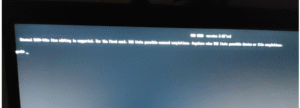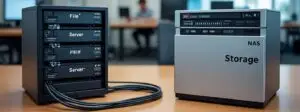
Top 25 System Administrator Interview Questions and Answers (2025)

The system administrator has really changed over the last 10 years. Now, it’s not just about keeping servers running. It’s also about doing things automatically, using cloud tech, protecting against online threats, and ensuring systems are always secure and operational. Whether you’re just starting or getting ready for a new job, knowing your stuff for interviews means understanding the basics and the newest tech.
This guide has 25 important system administrator interview questions that you might get asked in 2025. Each question has a good answer that shows you know the tech and have done it in real life, which is what hiring managers want to see.
Table of Contents
1. General System Admin Questions
2. Operating Systems & Infrastructure
3. Networking & Security
4 . Cloud & Virtualization
5. Troubleshooting & Problem Solving
6. Automation & Scripting
7. Behavioral and Situational
General System Admin Questions
1. Why did you choose to become a System Administrator?
Answer: I’ve always liked playing around with tech and fixing tricky problems. Being a system administrator is cool because you get to keep systems running well in the background. It feels good knowing my work helps people do their jobs without tech issues. The field is always changing. So, there’s always something to learn, like new automation tools or ways to fight online threats.
2. What would you say are your biggest strengths as a Sysadmin?
Answer: I’m good at figuring things out and staying calm when things get crazy. I have a way of finding and fixing issues fast. I’m also all about writing things down and doing things automatically. This cuts down on repeated tasks and messes. Also, I’m good at talking to people. I can explain tech stuff to people who aren’t techy. So, everyone knows what’s going on.
3. How do you keep your skills up to date?
Answer: I read tech blogs a lot, watch YouTube channels, and hang out in online groups like r/sysadmin on Reddit. I also like taking online classes. I’ve been checking out Kubernetes and IaC tools like Terraform recently. I set up test systems at home. It lets me mess around with new tech safely before using it for real at work.
4. Tell me about a tough technical issue you’ve handled.
Answer: At my last job, the network would randomly cut out in some offices. It was hard to fix because it didn’t happen all the time. After checking logs and capturing data, I found out it was a bad switch that would only fail when it was working hard. I replaced it and set up better network monitoring. So, we could catch problems like that sooner next time.
5. How do you communicate technical issues to non-technical users?
Answer: I talk about what it means for them instead of using tech words. If DNS is down, I won’t say, DNS isn’t resolving. I’ll say, the system that helps find websites is having problems. That’s why you can’t connect.” I always make sure they understand. I also give them realistic timeframes. So, they know when to expect things to be fixed.
Explore Related Tech Topics
Operating Systems & Infrastructure
6. What operating systems do you work with?
Answer: I can handle Windows Server and different versions of Linux. With Windows, I’ve dealt with Active Directory, Group Policy, PowerShell scripts, and services like DHCP and IIS. For Linux, I usually use Ubuntu and CentOS for server stuff. I set up web servers, manage software, script with Bash, and use Docker.
7. What steps do you take when a system slows down?
Answer: I start by finding out when it started, who’s having problems, and what’s slow. Then, I look at system stats like CPU, memory, disk use, and network traffic. Tools like Task Manager, top, and iostat are useful here. After that, I find out what’s causing the slowdown. It could be a program using too much memory, a hard drive issue, or a setting that’s not right.
8. How do you secure a server?
Answer: First, I update everything. Then, I make the OS more secure by turning off things we don’t need, setting up a firewall, and using hard passwords and MFA. I give users only the access they need. On Linux, I secure SSH. On Windows, I set tight Group Policies. Also, I do scans for weaknesses regularly and check logs all the time.
9. Can you explain what Active Directory is?
Answer: Active Directory is Microsoft’s system for managing users and resources on a network. It lets admins control access, set security rules, and organize things like users, computers, and printers. AD also lets people sign in once. So, they don’t have to log into every program separately.
10. What’s your backup strategy?
Answer: I follow the 3-2-1 rule: 3 copies of data, on 2 kinds of storage, with 1 offsite. I do small backups every day and full backups every week. I test backups all the time because if you don’t test, you don’t have a backup. I also figure out how long we can be down and how much data we can lose. So, we know what to expect if something goes wrong.
Networking & Security
11. Explain TCP/IP and DNS in simple terms.
Answer: TCP/IP is how computers talk to each other online. TCP makes sure the data gets there completely and in the right order. IP sends the data to the right place. DNS is like a phone book. It turns website names like google.com into IP addresses. So, your browser can find the website.
12. How would you handle a security breach?
Answer: I’d stop the breach right away and disconnect the systems that were affected. I’d figure out how it happened by checking logs. I’d clean the system, fix any weak spots, and restore from good backups. After it’s over, I write everything down and change security rules to avoid future breaches.
13. What’s the difference between static and dynamic IPs?
Answer: A static IP stays the same. It’s set by hand and used for servers or printers. A dynamic IP changes and is given out automatically by a DHCP server. Dynamic IPs are easier to manage for big networks and are usually used for user devices.
14. What is a firewall?
Answer: A firewall is like a guard for your network. It controls what comes in and out based on rules you set. It blocks hackers, viruses, and people who shouldn’t be there. It’s a must for network security.
15. How do you manage user permissions securely?
Answer: I give users only the access they need. I put users into groups by role, set group policies, and check access often. Also, I make sure people use MFA and strong passwords. I watch logs for anything weird.
Cloud & Virtualization
16. What virtualization tools have you used?
Answer: I’ve used VMware vSphere and Microsoft Hyper-V. I’ve set up ESXi hosts, managed VMs, and moved physical machines to virtual ones. With Hyper-V, I’ve worked with virtual networks, snapshots, and failover clustering. Virtualization makes things work better and more reliably.
17. What’s your experience with cloud services?
Answer: I’ve mostly used AWS: EC2 for servers, S3 for storage, and IAM for access control. I’ve also worked with VPC for network setups and CloudWatch for checking on things. I know the basics of Azure and GCP, and I’m always ready to learn more for a project.
18. What is Infrastructure as Code (IaC)?
Answer: IaC is when you manage infrastructure using code instead of setting things up by hand. Tools like Terraform or Ansible let you create servers, networks, and more in config files. This makes deploying faster, more consistent, and easier to track or check.
19. How do you ensure high availability and disaster recovery?
Answer: For virtual systems, I use clustering and failover systems. In the cloud, I put things in different regions or zones. For DR, I use automatic backups, off-site copies, and practice recovery often to make sure we’re ready if something bad happens.
Troubleshooting & Problem Solving
20. What do you do if a system goes down after an update?
Answer: First, I check if the update caused it. Then I try to undo it. If that doesn’t work, I start digging in: logs, settings, service status. While doing this, I let people know what’s happening and try to get things back up ASAP.
21. How do you manage multiple issues at once?
Answer: I sort by what’s most important and what’s affecting the most users. Critical outages come first. I use ticketing systems to keep track of everything and talk to users and team members. Sometimes, a quick fix makes it easier to deal with bigger issues. So, I stay flexible.
22. What if you don’t know the answer to a problem?
Answer: I look it up, check documentation, search for error messages, and check forums like Stack Overflow. If I need to, I ask a coworker or get help from the vendor. I try to learn fast and never guess without knowing.
Automation & Scripting
23. How do you use scripting in your role?
Answer: I automate daily tasks with PowerShell, Bash, or Python. For example, I’ve scripted automatic backups, log reading, and even creating user accounts. Scripting saves time, reduces mistakes, and keeps systems the same.
24. How do you manage updates across multiple systems?
Answer: I use central tools: WSUS for Windows, Ansible or Puppet for Linux. I test patches in a practice setup, schedule deployments for off-peak hours, and watch for problems. Doing this automatically makes sure updates are timely with very little disruption.
Behavioral & Situational
25.Tell me about a project where you worked with a team.
Answer: I worked on a project to move file servers to cloud storage. I did the data moving and scripting, worked with the network team to set up secure access, and helped users get used to the new setup. We finished early, and users liked how smooth it was.










